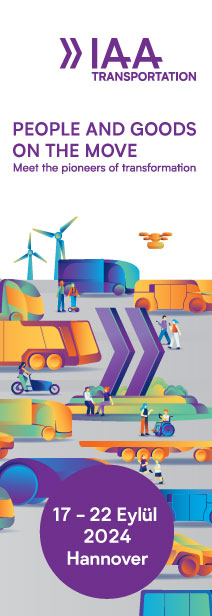The launch of Solaris Urbino hydrogen was announced in 2018. The energy needed to propel the bus is derived from hydrogen stored in bus roof-mounted tanks. By means of a fuel cell, the hydrogen gas is turned into electricity. In turn, that power is feeding directly the bus driveline which consists of an axle with electric engines (the ZF AxTrax mounted also on the battery electric Urbino and on the Mercedes eCitaro). The bus is also fitted with a Solaris High Power battery which acts as an additional electric power storage facility. According to the information released in June 2018, the Solaris Urbino 12 hydrogen has 29.2 kWh battery capacity.

Merceds put eCitaro in the spotlight
The Mercedes-Benz exhibition at the congress of the International Association of Public Transport (UITP) will be centred around the fully-electric low-floor Mercedes eCitaro urban bus, the comprehensive e-mobility system and innovative digital services.
Today the eCitaro is equipped with a maximum of 292 kWh battery split in 12 modules. Another step on the roadmap of the Mercedes eCitaro envisages the use of lithium-polymer batteries, also referred to as solid-state batteries, as an option in the future, Daimler says in a press release. These are characterised by a particularly long service life and high energy density. The first order for eCitaro with solid-state battery has already been signed.

Ballard Power System to launch a new generation fuel cell module
Ballard Power System will officially launch the 8th-generation heavy duty fuel cell power module, called FCmove. This component will be mounted on the double decker hydrogen bus by Wrightbus. FCmove range, Ballard points out, will deliver the performance and reduced total lifecycle cost required to meet the ambitious targets of the newly created H2Bus Consortium and deliver an attractive economic value proposition to bus operators.
Van Hool fuel cell bus towards Cologne
On Monday, June 10, 2019 at 3:00 pm on booth A1000 (Van Hool), it will be held the official handover of the keys of the first fuel cell bus (from an order of 40 units) to RVK Köln by Jan Van Hool, CTO at Van Hool, to Jens Conrad, Fachbereitsleiter Alternative Antriebe at Regionalverkehr Köln GmbH.
In February 2018 Van Hool announced a contract with RVK Köln and WSW Wuppertal (Germany), to supply 40 hydrogen buses of the latest generation, model Van Hool A330. This order consists of 30 fuel cell buses for Cologne and 10 for Wuppertal, making it the largest order for hydrogen-powered vehicles ever been placed in Europe. The first buses will be delivered beginning next month, in July of 2019. They will be equipped with the latest FCvelocity-HD85 Fuel Cell module from Ballard Power Systems
The procurement of these 40 fuel cell buses fits into the framework of Germany’s national innovation program for hydrogen and fuel cell technology (NIP), and is financed by the German Federal Ministry of Transport and Digital Infrastructure (BMVI), financed by the “Fuel Cells and Hydrogen Joint Undertaking” (FCH JU), the European public-private partnership is aimed at accelerating the market introduction of fuel cells and hydrogen technology, operating under the EU ‘Horizon 2020’ program.
Heliox: the charging station with energy storage
Heliox and InvertedPower announced their collaboration to bring to market a new generation of battery buffered high power charging stations. That is to say, charging stations where the energy provided to the vehicle comes both from the grid and from an energy storage system, in order to enable the high power “sprints” of charging power required for opportunity charging.
The new generation charging station (to date at the stage of the “product concept”) is named SprintCharge and is addressed to electric buses and electric trucks. It will complete Heliox portfolio with regards to high power charging infrastructure using key technologies of battery integration developed by InvertedPower.
CaetanoBus with electric bus
CaetanoBus will attend the UITP Summit in Stockholm with two “zero emission” products. Both the ebus e.City Gold and the chassis e.CC 100 feature a central electric motor by Siemens.
The zero emission bus CaetanoBus e.City Gold is a 100% electric urban bus fully developed by the Portoguese company. It features a capacity of up to 88 passenger and a maximum power of 160 kW thanks to the permanent magnet synchronous motor by Siemens. No information are available about the battery capacity: the technical sheet of the bus says it can be «individually configured». Led lights are mounted on the interiors and exteriors.

APOLLO-EU project sees the light
UITP is proud to announce the launch of APOLLO-EU, a new platform that will bring together European transport authorities and operators to boost and support the exchange of knowledge and expertise on clean bus deployment. APOLLO-EU will be officially launched during the UITP Global Public Transport Summit on 11 June at 14.30. The launch event will welcome Mohamed Mezghani, Secretary General of UITP, and Herald Ruijters, Director Investment, Innovative and Sustainable Transport of DG MOVE.
Many city administrations have the political will to re-orient their public transport system towards clean buses, but lack the capabilities and know-how to do so on their own. The APOLLO-EU platform will assist them in the learning and transition process, ensuring that technical, procedural and operational know-how on clean bus deployment is passed on beyond the circle of cities that can be considered front-runners. This will make possible that a critical mass of cities and operators start and continue investing in clean bus technologies.
The challenge taken by the APOLLO-EU Consortium is to ensure that the knowledge and experience gathered in the past is effectively transferred to a wide network of city stakeholders, supporting them in the transition towards cleaner and more sustainable bus systems.










